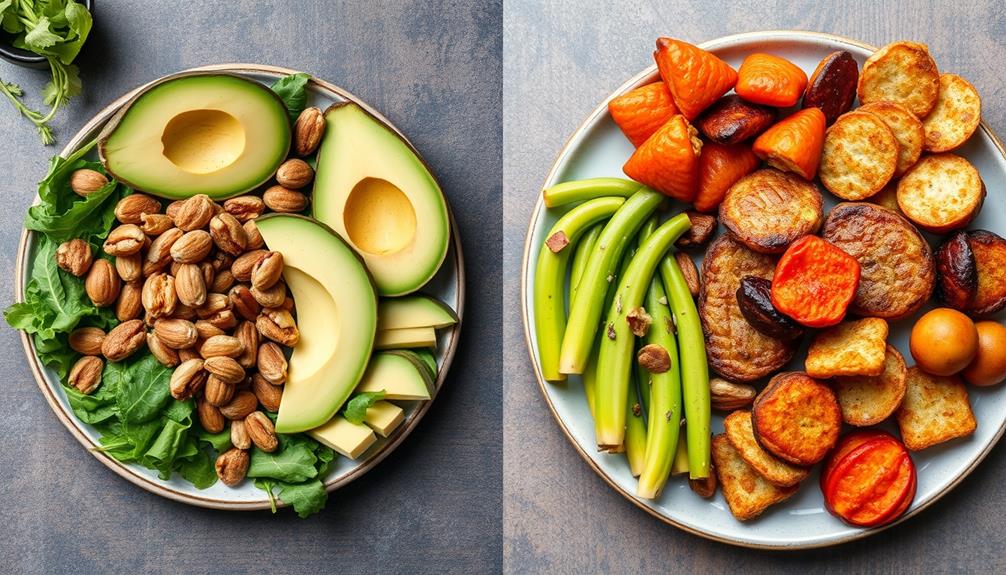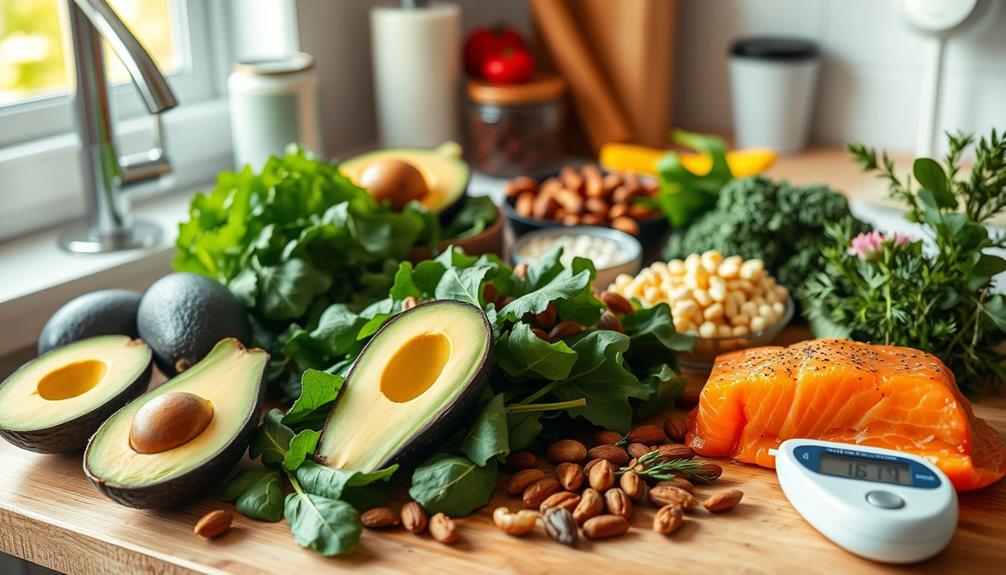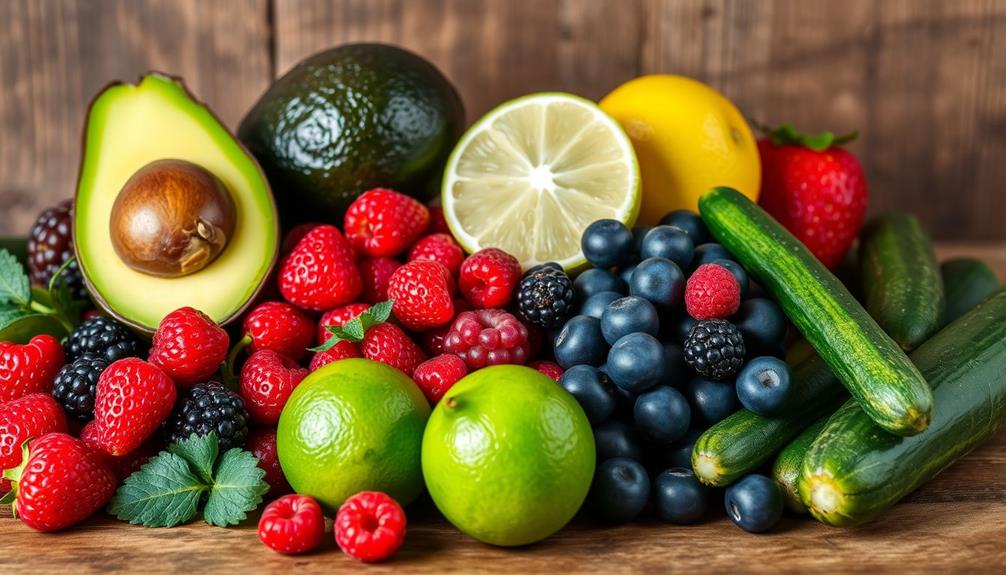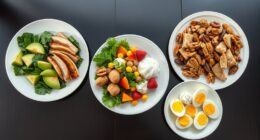A keto diet centers on high-fat, low-carb foods that help your body enter ketosis for energy. You'll aim for about 70-75% fat, 20-25% protein, and only 5-10% carbs, limiting your intake to 20-50 grams of net carbs daily. Healthy fats like avocados, olive oil, and nuts are essential, while you should include fatty cuts of meat and low-carb veggies. Avoid high-carb foods like bread, pasta, and sugary snacks. A typical day could include an omelet for breakfast, leftovers for lunch, and a protein-rich dinner. If you're curious about the health benefits and tips for success, there's much more to explore.
Key Takeaways
- The keto diet is a low-carb, high-fat diet that promotes ketosis for energy production, with a typical macronutrient ratio of 70-75% fat, 20-25% protein, and 5-10% carbohydrates.
- Key foods to include are healthy fats like avocados and olive oil, fatty meats, eggs, low-carb vegetables, and full-fat dairy products.
- Foods to avoid consist of high-carb items like bread, pasta, sugar, starchy vegetables, and most fruits, except for low-glycemic options like berries.
- Initial side effects, known as "keto flu," may include fatigue and headaches but typically resolve within a few days to weeks as the body adapts.
- Monitoring health markers and nutrient intake is crucial to balance benefits and avoid potential deficiencies while on the keto diet.
Overview of the Keto Diet

The ketogenic diet, often referred to as keto, is a low-carb, high-fat eating plan designed to shift your body into a state of ketosis. In this metabolic state, your body burns fat for energy instead of carbohydrates, which can lead to weight loss and improved blood sugar control.
To achieve ketosis, you'll need to limit your net carb intake to about 20-50 grams per day, focusing on high-fat foods like avocados, nuts, and fatty cuts of meat while avoiding sugary and starchy foods. Additionally, incorporating foods high in antioxidants, such as certain vegetables, can support overall health during your keto journey, as they can help mitigate some side effects of the diet, like the "keto flu" antioxidants for health.
The typical macronutrient ratio for the keto diet consists of approximately 70-75% fat, 20-25% protein, and only 5-10% carbohydrates. It's essential to monitor your protein intake, as too much can kick you out of ketosis.
You'll also want to choose keto-friendly foods that align with these ratios. As your body adapts to this new fuel source, you might experience initial side effects known as the "keto flu," which can include fatigue and headaches.
Fortunately, these symptoms usually resolve within a few days to weeks, allowing you to fully embrace the benefits of the ketogenic diet.
Key Foods to Include

When following the keto diet, it's essential to focus on healthy fats and protein sources.
Incorporating foods beneficial for managing gout symptoms can also support overall health, especially if you're looking to maintain a balanced diet.
You'll want to include foods like avocados, fatty meats, and low-carb vegetables to keep your meals satisfying and nutritious.
Let's explore the best options to fuel your body while maintaining ketosis.
Healthy Fats Selection
Choosing the right healthy fats is essential for your success on a ketogenic diet. These fats should make up about 70-75% of your total caloric intake. Start by incorporating olive oil and avocados, which are both rich in monounsaturated fats. They not only enhance flavor but also support your health.
Additionally, consider adding essential oils for toothache relief, as some oils like clove and peppermint can provide soothing benefits for overall well-being.
Don't forget about nuts and seeds like almonds, walnuts, and chia seeds. They provide a great combination of healthy fats, fiber, and protein, making them perfect for snacks or meal additions.
For those creamy textures, full-fat dairy products such as cheese and heavy cream can add richness to your meals while offering necessary fats.
Including fatty fish like salmon and mackerel in your diet will boost your intake of omega-3 fatty acids, which help reduce inflammation and improve heart health.
Additionally, consider using coconut oil or MCT oil for cooking and smoothies, as they contain medium-chain triglycerides that your body can quickly convert into ketones for energy.
Protein Sources Overview
Finding the right protein sources is essential for maintaining your ketogenic lifestyle. A well-balanced keto diet should also emphasize the importance of effective strategies for weight loss while ensuring you meet your nutritional needs.
Focus on incorporating fatty cuts of meat like ribeye and pork belly, which provide both protein and essential fats while keeping your carbohydrate intake low. Eggs are another excellent option, offering about 6 grams of protein per large egg with virtually no carbs, making them a staple in your keto diet.
Don't overlook fatty fish such as salmon and mackerel, which deliver around 22 grams of protein per 3-ounce serving along with heart-healthy omega-3 fatty acids.
Poultry options, particularly dark meat chicken and turkey, also fit perfectly into your plan, providing about 25 grams of protein per serving when prepared without breading or sugary sauces.
If you prefer plant-based protein, options like tofu and tempeh can be included as well. Tofu packs around 10 grams of protein per 100 grams and is low in net carbs, making it a suitable choice for vegetarians.
Foods to Avoid

Avoiding certain foods is essential for successfully following a keto diet. By steering clear of specific items, you can effectively manage your carbohydrate intake and maintain ketosis. Here's a quick guide on what to avoid:
| Food Category | Examples | Reason to Avoid |
|---|---|---|
| High-Carb Foods | Bread, pasta, rice | Increases carbohydrate intake |
| Sugary Foods | Candies, desserts, soda | High in simple carbohydrates |
| Starchy Vegetables | Potatoes, corn, peas | High carb content disrupts ketosis |
It's vital to eliminate sugary foods and beverages, as they can derail your keto goals. Starchy vegetables are also unsuitable, so opt for non-starchy alternatives instead. When it comes to fruits, limit them to low-glycemic options like berries. Processed foods packed with added sugars and unhealthy fats should also be avoided, as they not only hinder your progress but can lead to nutrition deficiencies. By being mindful of these foods to avoid, you'll enhance your chances of thriving on the keto diet.
Sample Meal Plan

Creating a meal plan that aligns with keto principles can simplify your journey and keep you on track. A well-structured keto meal plan focuses on high-fat foods while keeping carbs under 50 grams per day to maintain ketosis. This approach not only helps in managing weight but also supports overall financial health by reducing unnecessary food expenditures budgeting for meals.
Here's a sample to get you started:
- Breakfast options: Enjoy omelet bites or a bowl of keto yogurt.
- Lunches: Use leftovers from dinner, like prime rib or rotisserie chicken, to save time.
- Dinners: Savor protein-rich meals such as roasted salmon or customizable chicken, paired with low-carb vegetables like zucchini and broccoli.
- Snacks: Keep hunger at bay with cheese, pork rinds, or fresh veggies dipped in keto-friendly sauces.
Incorporating meal repetition can help you stay organized and focused on your goals. By reusing ingredients across meals, you'll not only simplify cooking but also guarantee you stick to your dietary restrictions.
This approach can make your keto journey enjoyable and sustainable. Remember, it's all about finding what works best for you while enjoying the deliciousness of high-fat foods and nourishing your body with the right nutrients!
Health Benefits and Risks

Exploring the health benefits and risks of the ketogenic diet reveals a complex picture that can significantly impact your wellness journey. One of the most notable health benefits is substantial weight loss, especially in the first 3-6 months. Studies suggest that you may shed more pounds on a keto diet compared to traditional balanced diets.
If you have type 2 diabetes, you might also experience improved glycemic control, with around 60% of participants achieving remission while following this diet. Additionally, individuals with certain mental health conditions, such as Borderline Personality Disorder, may find that dietary changes can influence their emotional stability and overall well-being.
However, it's important to take into account the risks. The keto diet can raise LDL cholesterol levels in some individuals, even as it lowers triglycerides and increases HDL cholesterol. You may also encounter initial side effects commonly known as "keto flu," including fatigue, headaches, and digestive issues, which usually resolve within days to weeks as your body adjusts to ketosis. Additionally, long-term adherence to the keto diet may lead to other complications, such as nutrient deficiencies or gastrointestinal disturbances due to the lack of fiber-rich foods. People who experience the *keto diet and digestive issues* may find relief by incorporating more low-carb, high-fiber vegetables to support gastrointestinal health. It’s crucial to monitor your body’s response and consult a healthcare professional if persistent symptoms arise.
Long-term adherence to the keto diet can lead to nutritional deficiencies due to its restrictive nature, necessitating careful planning and potential supplementation to guarantee you're meeting your nutritional needs. Balancing these health benefits and risks is vital as you navigate your dietary changes.
Tips for Success

Success on the ketogenic diet often hinges on a few key strategies that can make your journey smoother and more enjoyable. To thrive on keto, consider the following tips:
– Prioritize meal prep: Organize your ingredients and create a grocery list to stick to low-carb guidelines and avoid impulse buys. Focus on low-carb vegetables, high-quality proteins, and healthy fats.
Additionally, understanding the key domains of development in psychology can help you appreciate how dietary changes may influence emotional wellness during this change.
- Incorporate keto-friendly snacks: Keep snacks like nuts, cheese, and hard-boiled eggs handy to manage hunger between meals and resist high-carb temptations.
- Stay hydrated: Maintain hydration and electrolyte balance by drinking plenty of water and adding salt or potassium-rich foods to ease "keto flu" symptoms during adaptation.
- Track your macronutrient intake: Monitor your daily ratios—aim for 70-75% fats, 20-25% protein, and 5-10% carbohydrates for ideal ketosis.
Experiment with different cooking techniques and keto-friendly substitutes, like cauliflower rice and zucchini noodles, to keep meals exciting.
Frequently Asked Questions
What Foods Can You Eat on a Keto Diet?
On a keto diet, you'll enjoy high-fat foods like avocados and nuts, fatty meats, low-carb veggies, and moderate dairy. Snacks like hard-boiled eggs and olives keep you satisfied while staying within carb limits.
What Does a Normal Keto Diet Look Like?
A normal keto diet emphasizes high-fat, low-carb foods. You'll enjoy meals rich in avocados, cheese, and fatty fish, while avoiding grains and sugars. Planning meals helps you stay on track and maintain ketosis effectively.
What Foods Are Not Allowed on Keto?
You might think you're safe with certain foods, but watch out! Avoid high-carb items like bread, pasta, sugary snacks, starchy veggies, most fruits, and processed treats if you want to stay in ketosis.
What Is an Example of a Keto Meal Plan?
You can start your day with omelet bites, enjoy prime rib for lunch, and savor stuffed portobellos for dinner. For snacks, keep cheese or hard-boiled eggs handy to maintain your energy without exceeding carb limits.
Conclusion
In summary, adopting a keto diet can feel like opening a secret treasure chest of flavors and energy. By focusing on the right foods and avoiding the wrong ones, you'll not only transform your meals but also boost your overall health. Remember, it's all about balance and staying committed. So, grab your favorite keto snacks, stay inspired, and watch as you conquer your goals like a superhero on a mission! You've got this!









